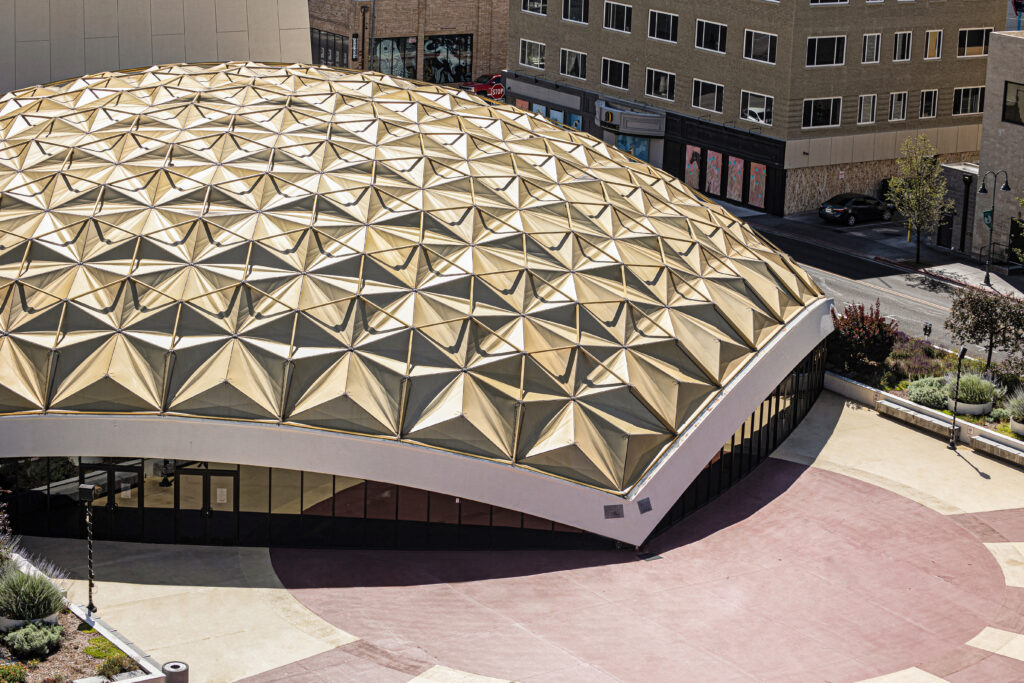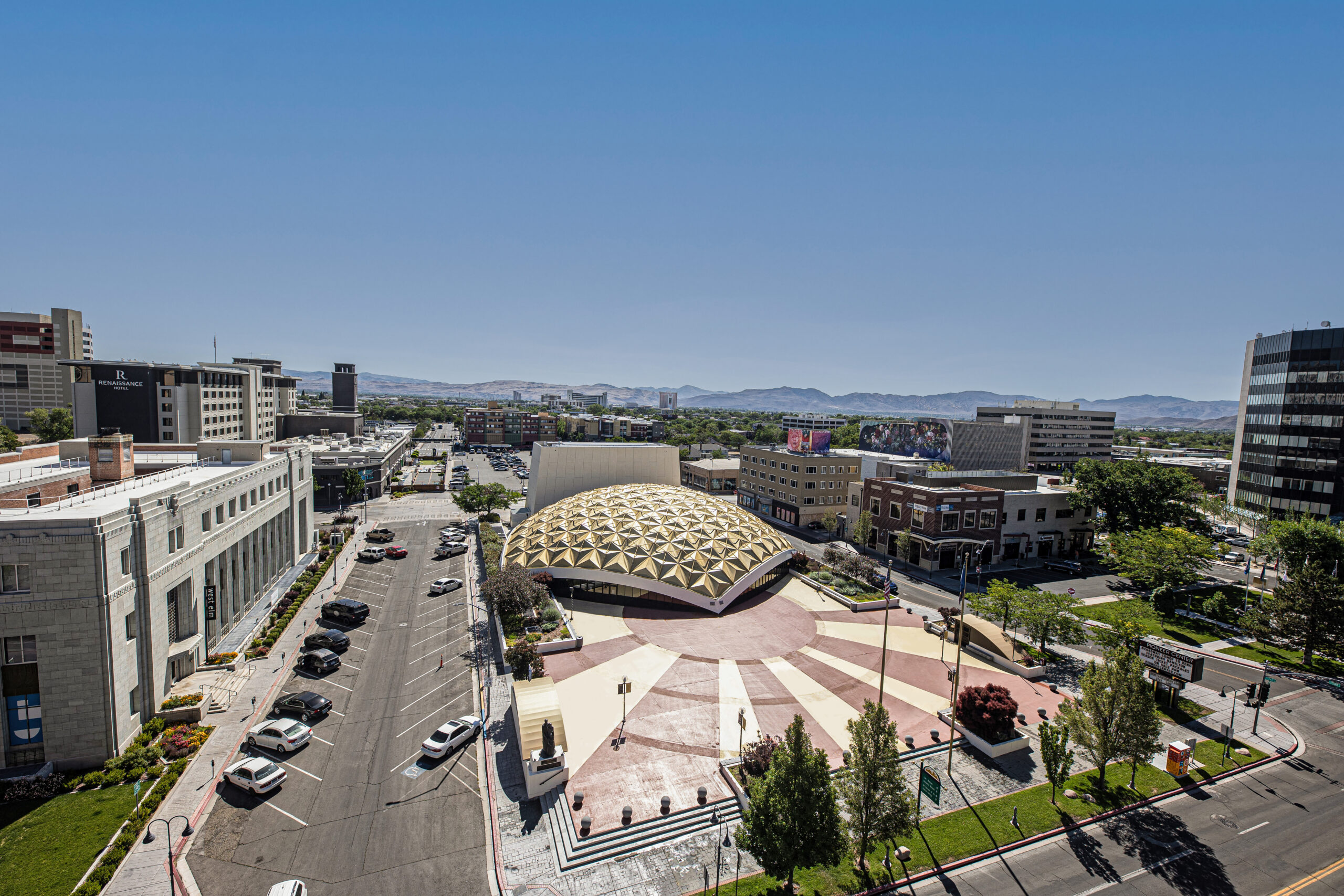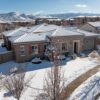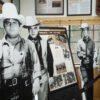If you have ever stepped foot in downtown Reno or driven down South Virginia Street, you have more than likely witnessed the golden hue cast by the Pioneer Center for the Performing Arts—a dome-shaped building nicknamed the “Golden Turtle.” With rich historical and architectural significance, the Pioneer Center celebrated its 55th year in January 2023, remaining a permanent staple in our biggest little mountain town community.
To learn more about how this one-of-a-kind theater forged its legacy in Northern Nevada, I interviewed Dennyse Sewell, Executive Director at the Pioneer Center. In our Q& A, Sewell shared how the Pioneer Center first came to fruition during the late 1960s and has since showcased some of the country’s most notable performers and theatrical performances, such as Broadway. She also provided insight into the nonprofit organization’s vision for the future.
“Throughout our history, we have been a partner, a collaborator, and a supporter of local arts organizations,” Dennyse Sewell, Executive Director at the Pioneer Center for the Performing Arts said. “Looking ahead, we are dedicated to forging new partnerships with local artists and nonprofit organizations as well as hosting new events that bring our diverse community together for a shared experience.”
Sewell spoke enthusiastically about the Pioneer Center’s efforts to help break down accessibility barriers with its educational outreach programs, world-class amenities, upgraded features, and partnerships in the community.
For more information on how the Pioneer Center for the Performing Arts came to be one of the best venues in the Reno-Sparks area and where it’s headed, keep reading.
Find Connection And Entertainment In Reno Like No Other At The Pioneer Center
1. What is the historical significance of the Pioneer Center?
Sewell says: Around the time when the Pioneer Center was founded, tremendous change and upheaval was occurring across the U.S. Our nation was experiencing greatness with events such as Apollo 11, Woodstock, and the Civil Rights Act. We also saw some of our worst tragedies, like the Vietnam War and the assassinations of President John F. Kennedy and Dr. Martin Luther King Jr.
Reno was undergoing many changes at that time as well. Our tourism industry was thriving, and our population was growing at an exponential rate, which brought regional leaders together to plan a new facility in the heart of downtown Reno to serve as both a performing arts venue and a convention facility.
The Pioneer Theater-Auditorium opened in January of 1968 and has been an anchor of Northern Nevada’s vibrant arts and culture scene since. In 1988, the building was renamed the Pioneer Center for the Performing Arts, where a private nonprofit cultural organization was also founded to preserve and manage the theater.
Our nonprofit became the sole owner of the Pioneer Center in 2012 after Washoe County deeded the land and the Reno-Sparks Convention and Visitors Authority deeded the building to us. Throughout all the changes in downtown Reno over the past 55 years, the Pioneer Center has remained a constant source of energy, vitality, and economic impact.
Our theater is among the quartet of historical landmarks at the heart of Reno’s civic center, including the Washoe County Courthouse, Riverside Hotel, and Historic Post Office. In recognition of the Pioneer Center’s historical and architectural significance, it is listed in the National, State, and City Registers of Historic Places.
We are also a proud member of the League of Historic American Theatres. 2023 marks the 55th anniversary of the Pioneer Center and its unique place in the Reno community. Over the past 55 years, the Pioneer Center has contributed significantly to Reno’s cultural identity, sharing a broad range of performing arts experiences with multiple millions of patrons.

2. How would you describe the Pioneer Center to someone who has never seen it in person?
Sewell says: The Pioneer Center is an exceptionally unique building. I believe there is no other place on earth quite like it. Our striking mid-century modern architecture is a true Reno landmark– we are an utterly original part of the fabric of this city that evokes such a strong sense of place for everyone who has lived here or visited the area.
Our primary distinctive feature is a gold-anodized geodesic dome resting on an expansive front plaza, facing directly onto downtown Reno’s main street. It has been affectionately nicknamed “the golden turtle” for the design of its geodesic dome and is described as having the appearance from the front of a bird that has swooped down to the ground with its wings spread.
The theater’s front entrance is a wall of glass panels in two identical graceful arcs that lead into the lobby area. From the lobby, patrons ascend onto the balcony or descend the grand staircases to the orchestra level.
The Pioneer Center takes up an entire city block and is almost entirely below ground, which is quite a feat for a plot of land adjacent to a river and, thus, below the water table. We may look deceptively small from the exterior, but our facility occupies over 55,000 square feet of interior space with a grand 1,488-seat main auditorium, a multi-use Exhibition Hall, and a 175-seat cabaret theater.
3. Have there been any significant building renovations?
Sewell says: There have been several significant capital improvement projects over the past 55 years to preserve, maintain, and upgrade the Pioneer Center, including:
- Renovating the front plaza, both functionally and aesthetically
- Expanding the footprint of the upper lobbies to provide for larger interior entrance space
- Adding additional restroom locations in the upper and lower lobbies to meet increased expectations of modern audiences—when originally constructed, the Pioneer Center had only four restroom stalls for women in the entire building!
- Creating a 175-seat cabaret theater called the Pioneer Underground
- Investing in an outdoor performance space, including lighting and sound equipment along with a raised stage suitable for all types of performances
- Upgrading the lighting and sound equipment in the main auditorium
- Increasing the facility’s energy efficiency by installing L.E.D. lighting, insulated glass, and a large solar panel array
- Improving patron comfort and safety by upgrading the building’s HVAC system, abating the original asbestos insulation, and refurbishing the original theater seating
- Expanding backstage dressing room areas to accommodate productions with larger casts
- Upgrading aesthetic finishes throughout the building, including carpet, wall coverings, light fixtures, and lobby seating
- Significantly improving the theater’s accessibility by installing automatic door openers to the front entrance, adding a wheelchair lift in the lower lobby, and creating wheelchair-accessible seating areas in the main auditorium
4. Are there plans to modernize the building while preserving historical elements?
Sewell says: Our vision for the future is certainly grand, and we are planning many more renovation and upgrade projects to ensure the Pioneer Center remains a premier performing arts center well suited to serve this community into the future.
Some of those plans include enhancing the theater’s original mid-century modern aesthetic in the interior finishes, upgrading the theater’s sound and lighting technical capabilities to the highest modern standards, providing world-class amenities for both patrons and performers, renovating our front plaza and marquees, and dramatically enhancing our exterior lighting and landscaping—to name a few!
As with all the previous capital improvement projects, our future work will ensure that the Pioneer Center’s historic integrity remains intact by keeping all the key iconic and historic features in their original form.
5. Who are some of the most notable performers to perform at the Pioneer Center?
Sewell says: The mission of our nonprofit organization is to cultivate exceptional performing arts experiences in our historic venue and throughout the region. It’s incredible to reflect on the 55 years of performances that have taken place on our stage. We’ve hosted an amazing range of events ranging from local children performing for their first time to professional artists on international tours. This has led to over half a century of music, dance, theater, opera, films, lectures, magic, comedy, and so much more.
View this post on Instagram
Some of the names that first come to mind are Vincent Price, Mandy Patinkin, Mikhail Baryshnikov, Itzhak Perlman, David Copperfield, John Prine, Linda Ronstadt, and David Sedaris. That’s just the tip of the iceberg because we could also talk about all the amazing productions by the Reno Philharmonic Orchestra, Nevada Opera Association, Nevada Festival Ballet, A.V.A. Ballet Theatre, and many other talented local performing arts organizations. Not to mention the rich and diverse range of touring arts groups presented by Artown or our own Broadway Comes to Reno series, which has presented over 175 Broadway musicals and plays, including The Book of Mormon, Les Miserables, Mamma Mia, and Hamilton.
6. How does the Pioneer Center foster growth for the performing arts in a small mountain town like Reno?
Sewell says: The Pioneer Center’s construction in 1968 was bold and visionary—an architectural expression of a sense of unbounded optimism in Reno’s future. Regional leaders believed this community deserved a multi-use performing arts space that could host a diverse range of live events year-round. They knew the heart of downtown was the ideal location to bring everyone together for these cultural experiences.
The construction of Reno’s first major independent and freestanding performing arts center enabled the Pioneer Center’s founders to create a true community venue whose sole purpose was to serve the region by presenting high-quality arts programming. It created a place to host world-class touring performances outside of the casino setting.
Building this theater also created a home for local arts organizations, giving them an accessible venue that could reliably host their productions on a grand scale. Over the years, the Pioneer Center has been home to several resident companies, including the Reno Philharmonic Orchestra and Nevada Opera Association, both of which were founded the year after the Pioneer Center was constructed. Other resident companies have included the Washoe County Community Concert Association, Sierra Nevada Masterworks Chorale, Nevada Festival Ballet, A.V.A. Ballet Theatre, and Artown.
The existence of our nonprofit performing arts center has been essential to the incubation, growth, and flourishing of Reno’s rich arts and culture community.
7. How does the Pioneer Center support student youth in the community?
Sewell says: Arts education has always been one of the key commitments of our organization. We’ve been operating an educational outreach division, Pioneer Center Youth Programs, for over 50 years that brings live performing arts programs into elementary schools and public libraries across eight Northern Nevada counties.
This outreach program has served more than 1 million children throughout the region with interactive, educational, and entertaining experiences from a broad range of culturally diverse art forms.
In addition to our outreach programming, we host school field trips on-site at the Pioneer Center for music, dance, and theater performances specifically designed for children. Our stage has also hosted hundreds of thousands of area youth performing through local dance studios, school groups, and music ensembles.
We recently created a new educational opportunity, Broadway Behind the Curtain, which provides area high school and college students with an opportunity to observe the technical load-in while learning about various careers in the performing arts. Broadway touring company members and Pioneer Center staff serve as the expert educators for this program. We also work to negotiate student pricing with our national Broadway tours to help ensure that students in our area have affordable access to world-class theatrical productions during their week-long stops in Reno.
It is also our future goal to create scholarship funds to help support students enrolled in performing arts degrees at the higher education institutions in our area.
8. Are there any specific theatrical styles the Pioneer Center is focused on showcasing more?
Sewell says: We will continue expanding our Broadway Comes to Reno series, growing the number of shows each season and putting together the most diverse and compelling lineups we can. We are also interested in adding some plays and family-friendly children’s programming to the musicals we present. Aside from the Broadway series, we are currently exploring possible new collaborations that would bring more contemporary live music events to the Pioneer Center.
View this post on Instagram
We are also interested in highlighting more diverse dance genres from local and touring artists. We have worked with several Spanish language promoters for comedy and theater events and would like to continue growing those offerings. In addition to the programming in our main auditorium, we are actively working on new opportunities to present events in our cabaret theater and outdoors on our front plaza.
In 2022, we premiered a new annual event, the Dog Days of Summer Dance Festival, a free outdoor performance concert designed to showcase, grow, and support diverse dancemakers from across our region. We are excited about the future possibilities for expanding community access to the arts through free and low-cost admissions and look forward to working with artists and organizations who have not typically performed at the Pioneer Center in past years.
9. What do you envision for the Pioneer Center in the next 5 to 10 years?
Sewell says: To be truly responsible stewards of this cultural treasure, we must continually evaluate our place in this community and our role in the future evolution of the region. As our area continues to grow and change, we, too, must grow and change.
One of our primary goals is to remain responsive to our community and its evolving needs. Our Board and staff have been engaging in thoughtful discussions about our namesake and what it means to be a pioneer in this modern era. We have been reflecting on our legacy from the past 55 years and also looking ahead to the future and our unique place in it.
We will look for ways to incorporate the literary and visual arts together with the performing arts for multi-disciplinary, impactful programming. We will support this community and as many of its citizens as possible by identifying and working to break down any barriers that prevent them from accessing our programming—whether those barriers are geographic, physical, or financial. We will strive to bring our vision to life: a community that is connected, enriched and inspired through the power of live performance.
At Dickson Realty, we are proud to support nonprofit organizations like the Pioneer Center for the Performing Arts in Reno. For more information on living in Northern Nevada, contact one of our neighborhood professionals today.



